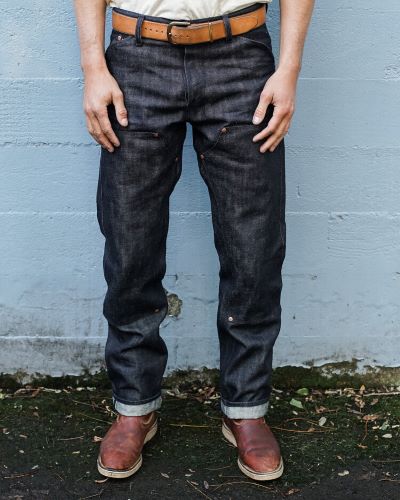Denim shops abound, but even more so denim brands. Jeans come in all price ranges, and Japanese jeans brand Moussy is more expensive than most.
The Moorthy Brand
of Moorthy A brand born in Japan in 2000. Moussy has opened stores across Asia and the United States.
Moussy offers multiple jean styles, from trendy to classic to hand-repaired denim, making it a favorite among celebrities and customers around the world. The brand has a lot of fans, but jeans come at a price.
This denim brand not only offers a wide range of styles and washes, but they do so in a socially conscious way.
From the production of denim fabric to the assembly and washing of clothes, it is produced in environmentally friendly domestic facilities. And the company prides itself on its remarkable attention to detail in the production of its garments.
Strong, thick, top-quality fabric shapes your body in the best Japanese denim tradition.
Why is domestic denim so expensive?
Denim produced in Japan generally refers to denim fabric woven on vintage shuttle looms, whereas the rest of the world uses modern looms.
Vintage looms are 60 to 80 years old, much slower, and can produce fabric lengths only half the width of modern denim rolls produced on modern machines.
This alone tells you how long it takes to produce jeans made in Japan. These original looms require a professional craftsman if they need repair and are operated by skilled workers.

Known as selvage denim, this type of denim production produces swaths of denim with colored threads secured at the finished edge without fraying.
These old looms are also capable of producing irregular textures, so there is no limit to the variety of textures and weaves that can be achieved, giving each type of denim its own unique feel.
Woven on old looms, the unique texture of the fabric sets Japanese denim apart from other denim options.
Dyeing of cloth yarn
Before weaving denim, the yarn must be dyed. Most Japanese denim producers have their own dyeing methods, some passed down through generations, others done by hand from start to finish. is highly specialized and time consuming.
Modern denim production uses colorfast chemical sulfur products to dye the yarn. However, Japanese manufacturers often prefer natural dyes, which makes quality control of the dye difficult.
denim weight
Also, Japanese denim tends to be a heavier fabric, weighing over 25 ounces per yard depending on the brand.
Heavier denim extends the life of the garment and increases the likelihood of the iconic fading associated with jeans. will increase.
Raw or Sanforized?
In the 1930s, a process called sanforization was introduced to make sizing jeans easier. Jeans were left in their raw state before sanforizing, so they shrunk when washed, making it a bit of a guesswork to get the right size.
Today, most of the jeans go through this process, and basically after the sizing is confirmed, they go on sale in stores, making them softer to the touch and more comfortable to wear than raw denim.
Denim made in Japan is either raw denim or sanforized.
Jean detailing
Japanese jeans also use high-quality hardware when making pants.Rivets and buttons are basically custom-made and have the company name on them. It may feature a unique design.
Other details include a coin pocket with selvedge threads, a custom back patch, multicolor stitching and fabric lined pockets.
Detailing takes time and many manufacturers use vintage sewing techniques on antique sewing machines.
fashion styling
Many Japanese brands, including Moussy, incorporate vintage styles into their fashion lines. These vintage styles not only reproduce American work and Western styles, but also include styles from the late 1800s to his 1940s.
Some Japanese denim brands are even able to accurately reproduce everything from the yarn to the hardware that affects the final price.
Advantages and disadvantages of domestic denim
Japanese denim has several attractive features compared to other manufacturing industries.
-
-
- Denim fabrics tend to be heavier and have a longer life
- Raw denim has unparalleled color fading
- Quality and exclusive details and hardware
- Large selection of denim thicknesses, colors and textures
- Limited production unique to jeans items
- quality production method
-
Drawbacks include:
-
-
- they are expensive
- Raw denim is stiff and can be uncomfortable at first
- Heavier denim fabrics can be too warm in hot climates
- Sizing can be difficult, especially for unsanforized denim
- Fading may require patience
-
mousie fashion
A high-fashion casual label, the Tokyo-based brand is known for adapting men’s styles to women’s wear. Denim is the company’s flagship product, and we are dedicated to each process of product manufacturing.
Moussy uses Japanese denim factories and washhouses to create jeans that make each pair unique. In 2016, Moussy created a line of vintage jeans.
In 2020, Moussy created a clothing line for sustainable production known as “M_”. The line uses recycled fibres, organic cotton and biodegradable materials.
Moussy now sells a wide variety of jeans. For men, there are skinny, slim tapered, wide tapered, stretch, straight, and rigid.
Women’s jeans styles are even more extensive and include boy skinny, reverse skinny, skinny, flared, rigid, stretch, tapered, wide tapered, slim straight, straight, wide straight, high rise and mid rise.
Conclusion
If you’re looking for cheap jeans for manual labor, you may not want to pay what Moussy jeans cost.
On the other hand, if you’re looking for very high quality denim produced in limited numbers and don’t mind a little time breaking them in, Japanese denim is the best choice.
Why Are Moussy Jeans So Expensive? The washes they offer are truly unique and literally impossible with new jeans.
Their clothes are well made and the fit they offer is exceptional. Their attention to detail is unrivaled. All things considered; the cost is understandable.


